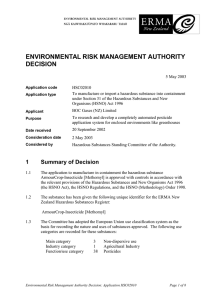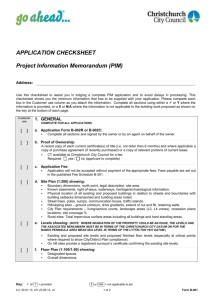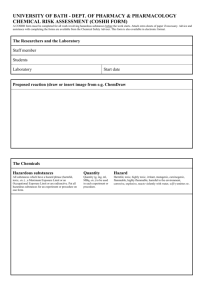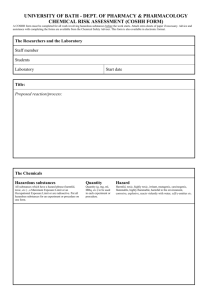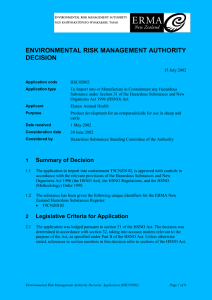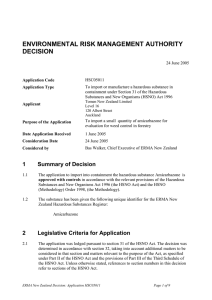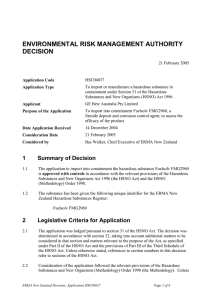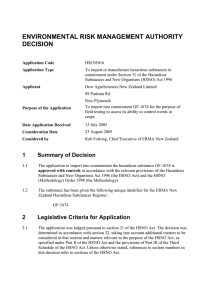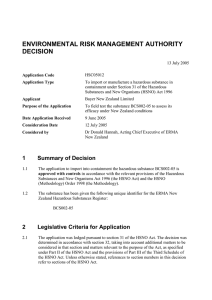ENVIRONMENTAL RISK MANAGEMENT AUTHORITY DECISION
advertisement
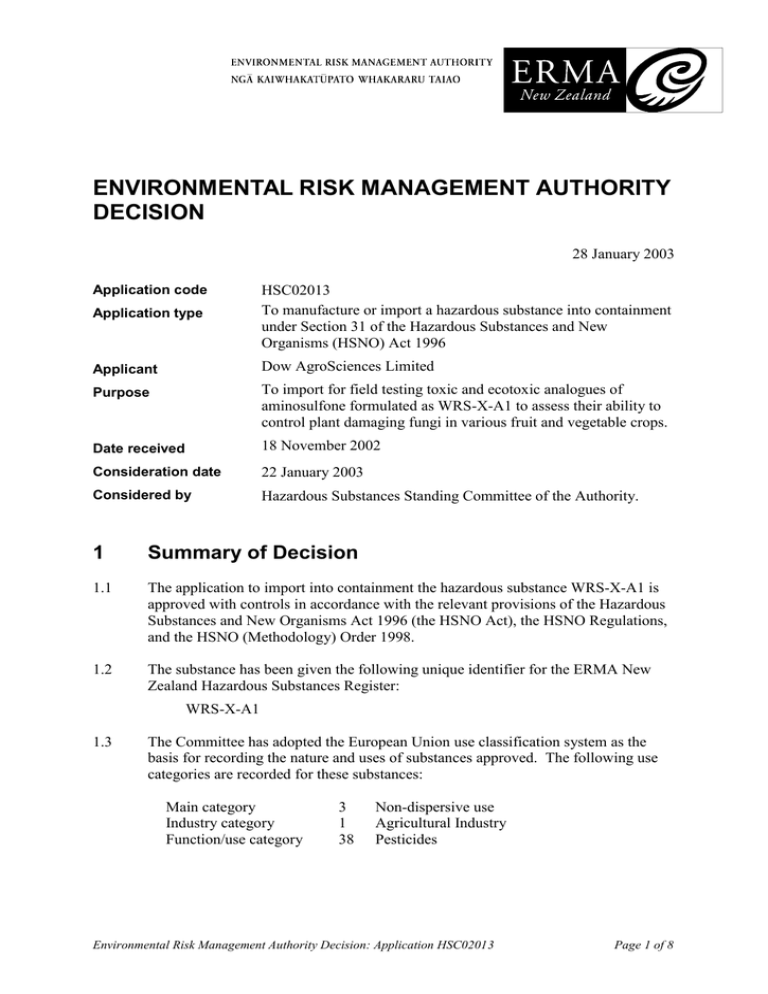
ENVIRONMENTAL RISK MANAGEMENT AUTHORITY DECISION 28 January 2003 Application code Application type HSC02013 To manufacture or import a hazardous substance into containment under Section 31 of the Hazardous Substances and New Organisms (HSNO) Act 1996 Applicant Dow AgroSciences Limited Purpose To import for field testing toxic and ecotoxic analogues of aminosulfone formulated as WRS-X-A1 to assess their ability to control plant damaging fungi in various fruit and vegetable crops. Date received 18 November 2002 Consideration date 22 January 2003 Considered by Hazardous Substances Standing Committee of the Authority. 1 Summary of Decision 1.1 The application to import into containment the hazardous substance WRS-X-A1 is approved with controls in accordance with the relevant provisions of the Hazardous Substances and New Organisms Act 1996 (the HSNO Act), the HSNO Regulations, and the HSNO (Methodology) Order 1998. 1.2 The substance has been given the following unique identifier for the ERMA New Zealand Hazardous Substances Register: WRS-X-A1 1.3 The Committee has adopted the European Union use classification system as the basis for recording the nature and uses of substances approved. The following use categories are recorded for these substances: Main category Industry category Function/use category 3 1 38 Non-dispersive use Agricultural Industry Pesticides Environmental Risk Management Authority Decision: Application HSC02013 Page 1 of 8 2 Legislative Criteria for Application 2.1 The application was lodged pursuant to section 31 of the HSNO Act. The decision was determined in accordance with section 32, taking into account matters relevant to the purpose of the Act, as specified under Part II of the HSNO Act and the provisions of Part III of the Third Schedule of the HSNO Act. Unless otherwise stated, references to section numbers in this report refer to sections of the HSNO Act. 2.2 Consideration of the application followed the relevant provisions of the Hazardous Substances and New Organisms (Methodology) Order 1998 (the Methodology). Unless otherwise stated, references to clauses in this decision refer to clauses of the Methodology. 3 Application Process 3.1 The application was formally received on 18 November 2002 and verified on 26 November 2002. 3.2 The following Government Departments were advised of the receipt of the application (in accordance with clause 2(2)(e)) and given the opportunity to comment. The Ministry of Health. The Department of Labour (Occupational Safety and Health). The New Zealand Food Safety Authority (Agricultural Compounds and Veterinary Medicines Group - ACVMG). The Department of Conservation. 3.3 The Ministry of Health responded that they had no comments to make relating to this application. 3.4 The information available to the Committee comprised: The application including as attachments commercially sensitive information The ERMA New Zealand Evaluation and Review Report 4 Consideration Sequence of the Consideration 4.1 In accordance with section 19(2)(b) of the HSNO Act, the Authority appointed Mr. Tony Haggerty (Chairperson) and Prof. George Clark to consider the application. The application was considered on 22 January 2003. 4.2 In accordance with section 32 of the Act, the approach adopted by the Committee was to confirm whether the application was for one of the purposes specified in section 30, to identify and assess the risks and to determine whether the substance could be adequately contained by controls to provide for each of the matters specified in Part III of the Third Schedule of the Act. Environmental Risk Management Authority Decision: Application HSC02013 Page 2 of 8 Purpose of the Application 4.3 The applicant states that the purpose of the application is to seek approval to import the substance WRS-X-A1 for field trial work. WRS-X-A1 is a base formulation containing varying amounts of aminosulfone analogues. The aim of the trial work is to determine the efficacy of these analogues in controlling fungi infecting grapes, potatoes, tomatoes and onions. 4.4 As the purpose amounts to “research and development on any hazardous substance”, the Committee considers that the application qualifies for consideration under sections 30(b) and 30(ba). Hazardous properties of the Substance 4.5 The Committee acknowledges that the physical properties and hazard properties of the substance have been described by the applicant, and that there is some extent of uncertainty due to the fact that this is a research substance on which not much knowledge is currently established. 4.6 The Committee notes that a containment application does not require a rigorous assessment of the hazard classification but only sufficient understanding of the hazardous properties to ensure that the containment controls are appropriate and adequate. The applicant has assessed the hazardous properties and described the hazard profile in sufficient detail and based on verifiable evidence to satisfy the requirements of a containment application. 4.7 The Committee agrees with ERMA New Zealand that the substance has the following hazard profile: WRS-X-A1 Hazard profile Flammability Acute Toxicity (oral/inhalation) Skin Irritation Eye Irritation Reproductive/Developmental Toxicity Target Organ Systemic Toxicity Aquatic Ecotoxicity Identification and Evaluation of the Significant Risks of the Substance 4.8 In accordance with sections 5, 6, and 8 and clauses 9 and 11, the Committee considered the potential risks of escape from containment under the headings of environmental, human health and welfare and Māori issues and concerns. 4.9 The applicant has identified a number of risks to the environment and to human health and welfare. The Committee accepts the applicant’s risk assessment and considers that, taking into account the proposed containment regime and controls in Environmental Risk Management Authority Decision: Application HSC02013 Page 3 of 8 place under other legislation, there are no significant risks to the environment or to human health and welfare. 4.10 On the basis of information in the Evaluation and Review report the Committee considers there are no issues or concerns to Māori. The Committee considered that the outcomes of the research on the substances proposed in the application may have benefit to Māori involved in the horticultural industry. 5 Containment and Controls 5.1 The Committee evaluated the adequacy of the containment arrangements of the applicant and the proposed controls in the Evaluation and Review Report. The Committee notes that these cover the following requirements, thereby addressing the matters set out in Part III of the Third schedule of the Act. To limit the likelihood of escape of any contained hazardous substances or contamination by hazardous substances. To exclude organisms from a facility. To exclude unauthorized people from the facility. To prevent unintended release of the substance by experimenters working with the substances. To control the effects of any accidental release of the substances. Inspection and monitoring requirements. Qualifications required of the person responsible for implementing the controls. 5.2 The Committee considered a request from the applicant to modify a control proposed in the E&R report relating to trial sites having to be a minimum distance of 50 metres away from areas that are inhabited, or have people working, to include an exemption for research stations. This was on the basis that it would be difficult to meet the latter criterion as there would be scattered machinery (such as irrigation pumps and controller sheds) where people would work from time to time. On a research station personnel would be suitably knowledgeable about field trials so as to be able to minimise or avoid exposure. The Committee agreed that the control should be reworded to take this into account. 5.3 The Committee is satisfied that with adherence to the management plans proposed by the applicant, and the controls listed in Appendix 1, the substance can be adequately contained. 6 Decision 6.1 The Committee has considered this application under section 31 to import into containment hazardous substances, and pursuant to section 32, the Committee is satisfied that this application is for one of the purposes specified in section 30, being sections 30(b) and 30(ba). 6.2 The Committee is satisfied that given the controls imposed, the substance can be adequately contained. Environmental Risk Management Authority Decision: Application HSC02013 Page 4 of 8 6.3 In accordance with clause 36(2)(b) of the Methodology the Committee records that, in reaching this conclusion, it has applied the criteria specified in section 32 of the Act. 6.4 It has also applied the following criteria in the Methodology: clause 9 - equivalent of sections 5, 6 and 8; clause 11 – characteristics of substance; clause 21 – the decision accords with the requirements of the Act and regulations; clause 22 – the evaluation of risks – relevant considerations; clause 24 – the use of recognised risk identification, assessment, evaluation and management techniques; 6.5 The application to import into containment the hazardous substance WRS-X-A1 is thus approved, with controls, as set out in Appendix 1. Mr Tony Haggerty Date 28th January 2003 Chair, Hazardous Substances Committee Environmental Risk Management Authority Decision: Application HSC02013 Page 5 of 8 Appendix 1: Controls 1. TO LIMIT THE LIKELIHOOD OF ESCAPE OF ANY CONTAINED HAZARDOUS SUBSTANCES OR CONTAMINATION BY HAZARDOUS SUBSTANCES 1.1. The trials shall be undertaken in accordance with the Aminosulfone Analogues Project Plan and Waireka Management Plan, which accompanied the application except where the following controls direct otherwise. Modifications of the Project Plan or Management Plan may be approved in writing by ERMA New Zealand providing that they comply with the following controls. 1.2. The substance shall be applied by way of hand-held/operator-worn equipment, using hydraulic pressure or compressed CO2 or air on plots specifically designated and marked for each treatment. 1.3. The trial sites shall be chosen so as to prevent any of the substance entering any surface water or groundwater system. 1.4. All trial sites shall be at least 50 metres from buildings where people live or work (commercial and research glasshouses and buildings on research stations where the trial is being conducted being exceptions). 1.5. Spraying shall be in accord with Section 5 of the Code of Practice for the Management of Agrichemicals NZS8409: 1999. 1.6. Sprayed produce shall be disposed of by either ploughing in, mulching or at an appropriate local authority operated landfill. 1.7. No sprayed produce shall be consumed by people or animals or offered for sale. 1.8. Access to the trial site(s) shall be by permission of the Trial Director or owner of the property on which it is located. The trial site(s) shall be secured by stock proof fencing and all potential access points shall be signed indicating that unauthorized access is not allowed, that the site is subject to a trial, and that the crops should not be removed or disturbed. 1.9. The substance shall be securely packed in containers that meet international regulations or comply with The Land Transport Rule: Dangerous Goods 1999, and that are identified in accordance with the Hazardous Substances (Identification) Regulations 2001. 1.10. The transportation of the substance shall comply with The Land Transport Rule: Dangerous Goods 1999. 1.11. Storage of the substance shall be in accordance with the Code of Practice for the Management of Agrichemicals NZS8409: 1999. 1.12. Any portion of the substance (undiluted) surplus to requirements shall be disposed of by the following method: Returning it to Dow AgroSciences New Zealand Ltd. Environmental Risk Management Authority Decision: Application HSC02013 Page 6 of 8 1.13. The trial site boundaries shall be clearly marked and distinctly visible from outside the trial site throughout the life of the trial(s). The existence of the trial shall be clearly marked to avoid accidental/incidental access and harvesting of treated crop or produce. 2. TO EXCLUDE ORGANISMS OR CONTROL ORGANISMS 2.1. Grazing animals shall be excluded from all trial sites, including buffer zones, by stock proof fencing for the duration of the trial period. The trial period means the period of the date of initial application of the substance to the date of site close-off in accordance with Control 6.6. (See also control 1.8.) 2.2. Crops shall not be treated during flowering or when bees are foraging. 3. TO EXCLUDE UNAUTHORISED PEOPLE 3.1. Access to each trial site(s) shall be by permission of the Trial Director or owner of the property on which it is located. The trial facility or site(s) shall be secured by stock proof fencing and all potential access points shall be signed indicating that unauthorised access is not allowed, that the site is subject to a trial, and that the crops or produce should not be removed or disturbed. 4. TO PREVENT UNINTENDED RELEASE OF THE SUBSTANCES BY EXPERIMENTERS WORKING WITH THE SUBSTANCES 4.1. The amount of the substance taken into each trial site shall be pre-measured so as to be sufficient for the application to the designated site. 4.2. The dispensing of the substance from the original imported container will be in a controlled environment (for example, storage area) to minimise inadvertent release, spillage, and unnecessary exposure. Dispensing will take place prior to transportation to each trial site for application if possible. 4.3. The mixing and dilution of the substance will comply with section 5.5 of the Code of Practice for the Management of Agrichemicals NZS8409: 1999. 4.4. Any surplus spray mix shall be disposed of at the trial site(s) by being further diluted and sprayed over a marked and designated non-crop and non-grazed area at the site. 4.5. The equipment used shall be rinsed after use with the appropriate detergent or decontaminant, and rinsate similarly disposed of at the trial site by being sprayed over a marked and designated non-crop and non-grazed area at the site. Environmental Risk Management Authority Decision: Application HSC02013 Page 7 of 8 5. TO CONTROL THE EFFECTS OF ANY ACCIDENTAL RELEASE OF THE SUBSTANCES 5.1. Any accidental spillage of the unmixed substance or spray mix shall be either diluted with water, sand or earth, and then spread over a marked and designated non-crop and non-grazed area at the trial site, or taken to an approved landfill. 5.2. To minimise the effects of any accidental release of the substance, the container label shall carry appropriate safety precautions and relevant first aid measures for immediate action pending medical attention. 5.3. Should an accidental release and exposure occur, normal precautions (such as the careful washing of hands, face, clothing, and equipment) shall be observed. 6. INSPECTION AND MONITORING REQUIREMENTS 6.1. The Trial Director shall keep track of all use of the substance as per section 5.9.1 of the Code of Practice for the Management of Agrichemicals NZS8409: 1999. 6.2. Occupational Safety & Health, Head Office [Attn HSNO Project Manager (OSH) or equivalent position] and ERMA New Zealand shall be informed in writing of the locations, start, and completion of the field trials. 6.3. If for any reason a breach of containment occurs, the Trial Director shall notify OSH and ERMA New Zealand within 24 hours of the breach being detected. 6.4. The Authority or its authorised agent or properly authorised enforcement officers, may inspect the facilities and trial sites at any reasonable time in accordance with the Management Plan. 6.5. This approval is for 3 years from the date at which Dow AgroSciences New Zealand Ltd notify ERMA New Zealand of the trial’s commencement. 6.6. Site Close off – The Trial Director shall ensure that at the trial site residue levels for components A & B shall be below international cut-off levels for toxicological or ecotoxicological concern, or show that the environmental fate of these components is such that they are not readily available and will not move off the site. This includes any areas used for the preparation or disposal of the spray mix. 7. QUALIFICATIONS REQUIRED OF THE PERSON RESPONSIBLE FOR IMPLEMENTING THE CONTROLS 7.1. The personnel applying the substance to the crops shall be GROWSAFE certified. Environmental Risk Management Authority Decision: Application HSC02013 Page 8 of 8


